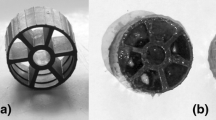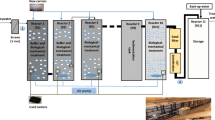Abstract
Performance of moving bed biofilm reactor system for a real hospital wastewater (HW) was experimented, modelled, and optimized using response surface methodology. Prior to conducting laboratory tests, design of the experiments was evaluated to minimize any prediction error. Statistical analyses demonstrated the models’ validity and adequacy for anticipation of the removal of BOD and COD by the process. The models predictions (with desirability of 0.98) were found to be in very good agreement with confirmative experiments results. The results indicated that under convenient operating conditions of the studied variables (packing rate 70%, HRT 24 h, and MLSS 3000 mg/L), the removal efficiencies for BOD and COD were 97.8 and 95.6%, respectively. Moreover, kinetics of the biological process showed that removal of organic matters for the tested wastewater adheres to modified Stover–Kincannon model with a correlation coefficient of 0.998. Ratio of BOD to COD of 0.6 (optimal range for biological treatment normally is >0.5) suggests acceptable efficiency of the reactor for decomposing organic load. A high overall efficiency of the process and fulfilling the related standards make this system an appropriate option for treating HDW.






Similar content being viewed by others
References
Accinelli C, Saccà ML, Mencarelli M, Vicari A (2012) Application of bioplastic moving bed biofilm carriers for the removal of synthetic pollutants from wastewater. Bioresour Technol 120:180–186. doi:10.1016/j.biortech.2012.06.056
Ahmadi E, Gholami M, Farzadkia M, Nabizadeh R, Azari A (2015) Study of moving bed biofilm reactor in diethyl phthalate and diallyl phthalate removal from synthetic wastewater. Bioresour Technol 183:129–135. doi:10.1016/j.biortech.2015.01.122
Amin MM, Khiadani MH, Fatehizadeh A, Taheri E (2014) Validation of linear and non-linear kinetic modeling of saline wastewater treatment by sequencing batch reactor with adapted and non-adapted consortiums. Desalination 344:228–235
Baker MD, Simkins S, Spokas LA, Veneman PLM, Xing BS (2014) Comparison of phosphorus sorption by light-weight aggregates produced in the United States. Pedosphere 24:808–816
Behbahani M, Moghaddam MA, Arami M (2011) Techno-economical evaluation of fluoride removal by electrocoagulation process: optimization through response surface methodology. Desalination 271:209–218
Calderón K, Martín-Pascual J, Poyatos JM, Rodelas B, González-Martínez A, González-López J (2012) Comparative analysis of the bacterial diversity in a lab-scale moving bed biofilm reactor (MBBR) applied to treat urban wastewater under different operational conditions. Bioresour Technol 121:119–126. doi:10.1016/j.biortech.2012.06.078
Casas ME et al (2015) Biodegradation of pharmaceuticals in hospital wastewater by a hybrid biofilm and activated sludge system (Hybas). Sci Total Environ 530:383–392
Cruz-Morató C et al (2014) Hospital wastewater treatment by fungal bioreactor: removal efficiency for pharmaceuticals and endocrine disruptor compounds. Sci Total Environ 493:365–376
De Gryze S, Langhans I, Vandebroek M (2007) Using the correct intervals for prediction: A tutorial on tolerance intervals for ordinary least-squares regression. Chemom Intell Lab Syst 87:147–154
Delnavaz M, Ayati B, Ganjidoust H (2009) Treatment of wastewater containing aniline using a moving bed biofilm reactor (MBBR). J Water Wastewater 68:9–18
Design-expert software (2011). In: Trial Version 8.0.7.1 User’s Guide
Dordio A, Carvalho AJP (2013) Constructed wetlands with light expanded clay aggregates for agricultural wastewater treatment. Sci Total Environ 463:454–461
Eaton AD, Franson MAH, American Public Health A, American Water Works A, Water Environment F (2005) Standard methods for the examination of water & wastewater. American Public Health Association, Washington
Faridnasr M, Ghanbari B, Sassani A (2016) Optimization of the Moving-bed Biofilm Sequencing Batch Reactor (MBSBR) to control aeration time by kinetic computational modeling: simulated sugar-industry wastewater treatment. Bioresour Technol. doi:10.1016/j.biortech.2016.02.047
Ferrai M, Guglielmi G, Andreottola G (2010) Modelling respirometric tests for the assessment of kinetic and stoichiometric parameters on MBBR biofilm for municipal wastewater treatment. Environ Model Softw 25:626–632
Hosseiny S, Borghei S (2002) Modelling of organic removal in a moving bed biofilm reactor (MBBR). Sci Iran 9:53–58
Jf S, Xx L, Wei L, Ma F, Sc Z, Sc S (2016) Performance and microbial communities of Mn(II)-based autotrophic denitrification in a Moving Bed Biofilm Reactor (MBBR). Bioresour Technol 211:743–750. doi:10.1016/j.biortech.2016.03.101
Jin R-C, Xing B-S, Ni W-M (2013) Optimization of partial nitritation in a continuous flow internal loop airlift reactor. Bioresour Technol 147:516–524. doi:10.1016/j.biortech.2013.08.077
Lee J, Ahn W-Y, Lee C-H (2001) Comparison of the filtration characteristics between attached and suspended growth microorganisms in submerged membrane bioreactor. Water Res 35:2435–2445. doi:10.1016/S0043-1354(00)00524-8
Lee Y, Kovalova L, McArdell CS, von Gunten U (2014) Prediction of micropollutant elimination during ozonation of a hospital wastewater effluent. Water Res 64:134–148
Martín-Pascual J, López-López C, Cerdá A, González-López J, Hontoria E, Poyatos J (2012) Comparative kinetic study of carrier type in a moving bed system applied to organic matter removal in urban wastewater treatment. Water Air Soil Pollut 223:1699–1712
Metcalf E (2003) Wastewater engineering: treatment and reuse. McGraw-Hill, New York
Mohammad Yari N, Balador A (2008) Performance of MBBR in the treatment of combined municipal and industrial wastewater a case study: Mashhad sewage treatment plant of Parkandabad. Water Wastewater 19:38–46
Moussavi G, Leili M, Nadafi K (2016) Investigation of furfural biodegradation in a continuous inflow cyclic biological reactor. Water Sci Technol 73:292–301
Ødegaard H (2006) Innovations in wastewater treatment: the moving bed biofilm process. Water Sci Technol 53:17–33
Organization WH (2006) Guidelines for the safe use of wastewater, excreta and greywater: policy and regulatory aspects, vol 1. World Health Organization, Geneva
Prasertkulsak S, Chiemchaisri C, Chiemchaisri W, Itonaga T, Yamamoto K (2016) Removals of pharmaceutical compounds from hospital wastewater in membrane bioreactor operated under short hydraulic retention time. Chemosphere 150:624–631
Sahariah BP, Chakraborty S (2011) Kinetic analysis of phenol, thiocyanate and ammonia-nitrogen removals in an anaerobic–anoxic–aerobic moving bed bioreactor system. J Hazard Mater 190:260–267. doi:10.1016/j.jhazmat.2011.03.038
Samarghandi MR, Khiadani M, Foroughi M, Nasab HZ (2016) Defluoridation of water using activated alumina in presence of natural organic matter via response surface methodology. Environ Sci Pollut Res 23:887–897
Shore JL, M’Coy WS, Gunsch CK, Deshusses MA (2012) Application of a moving bed biofilm reactor for tertiary ammonia treatment in high temperature industrial wastewater. Bioresour Technol 112:51–60. doi:10.1016/j.biortech.2012.02.045
Vera Candioti L, De Zan MM, Cámara MS, Goicoechea HC (2014) Experimental design and multiple response optimization. Using the desirability function in analytical methods development. Talanta 124:123–138. doi:10.1016/j.talanta.2014.01.034
Verlicchi P, Al Aukidy M, Zambello E (2015) What have we learned from worldwide experiences on the management and treatment of hospital effluent?—An overview and a discussion on perspectives. Sci Total Environ 514:467–491
Wang S, Chandrasekhara Rao N, Qiu R, Moletta R (2009) Performance and kinetic evaluation of anaerobic moving bed biofilm reactor for treating milk permeate from dairy industry. Bioresour Technol 100:5641–5647. doi:10.1016/j.biortech.2009.06.028
Wen X, Ding H, Huang X, Liu R (2004) Treatment of hospital wastewater using a submerged membrane bioreactor. Process Biochem 39:1427–1431
Zhang S et al (2014) Impacts of temperature and nitrifying community on nitrification kinetics in a moving-bed biofilm reactor treating polluted raw water. Chem Eng J 236:242–250
Zinatizadeh AAL, Ghaytooli E (2015) Simultaneous nitrogen and carbon removal from wastewater at different operating conditions in a moving bed biofilm reactor (MBBR): process modeling and optimization. J Taiwan Inst Chem Eng 53:98–111. doi:10.1016/j.jtice.2015.02.034
Acknowledgements
The research was supported by Hamedan University of Medical Sciences, Hamedan, Iran (Grant No. 9310235188).
Author information
Authors and Affiliations
Corresponding author
Additional information
Editorial responsibility: Necip Atar.
An erratum to this article is available at http://dx.doi.org/10.1007/s13762-017-1326-y.
Electronic supplementary material
Below is the link to the electronic supplementary material.
Rights and permissions
About this article
Cite this article
Shokoohi, R., Asgari, G., Leili, M. et al. Modelling of moving bed biofilm reactor (MBBR) efficiency on hospital wastewater (HW) treatment: a comprehensive analysis on BOD and COD removal. Int. J. Environ. Sci. Technol. 14, 841–852 (2017). https://doi.org/10.1007/s13762-017-1255-9
Received:
Revised:
Accepted:
Published:
Issue Date:
DOI: https://doi.org/10.1007/s13762-017-1255-9




